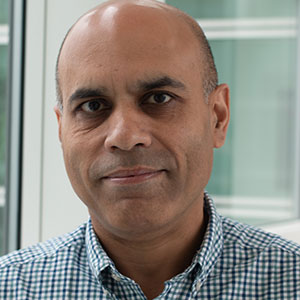Setnam Shemar is the Science Area Leader for the National Time Scale group at NPL’s Time and Frequency Department. He joined NPL in 1998 after earning a BSc (Hons) in Physics with Astrophysics from the University of Manchester and a PhD in Radio Astronomy from Jodrell Bank Observatory, also part of the University of Manchester. Before NPL, he worked as an analyst/software engineer in industry. From 2002 he spent time at QinetiQ as a Senior Scientist, focusing on geolocation and timing in Galileo and GPS, before returning to NPL in 2008.
Setnam’s specialist area of research is time and frequency transfer using space-based methods, including state-of-the-art methods for comparing optical clocks over international and intercontinental distances. He has been the technical lead for several European Space Agency (ESA) and UK Space Agency funded projects and is the UK’s lead scientist for ESA’s Atomic Clock Ensemble in Space (ACES) mission, which is a collaboration involving several countries on the International Space Station.
Setnam is a Fellow of the Institute of Physics and represents NPL in the following international committees; the Consultative Committee for Time and Frequency (CCTF), the CCTF Task Group on Continuous UTC, the ITU-R Working Party 7A and ESA’s Investigator Working Group on ACES.
Areas of interest
- Advanced satellite-based time transfer techniques for comparisons of national time scales and optical clocks globally and tests of fundamental physics
- Designing and operating national time scales
- Designing and implementing robust optical fibre-based time and frequency transfer systems for linking time scales
- Timing applications of pulsars e.g. positioning, navigation and time transfer
- Diversity and inclusion, promoting an inclusive culture where staff from all backgrounds are supported and empowered
- Outreach activities, e.g. demonstrating time dilation at the top of a skyscraper.
Key publications
- A new resilient time and frequency infrastructure for UTC(NPL)
D. J. M. Jones, M. Aikomo, S. Ashford, A. Ashkhasi, J. A. Davis, B. Devine, B. Eglin, S. B. Everett, R. Foot, D. Galbraith, R. J. Hendricks, K. Khatry, C. Langham, R. Lewis, J. Newton-Griffiths, H. Owen, S. L. Shemar, A. Sheppard, C. Smyth, K. Szymaniec, S. Walby, D. F. M. Weston, J. Whale, P. B. Whibberley, A. Wilson, C. Wilson and H. S. Margolis
2889, 012025 (2024)
- Direct comparisons of European primary and secondary frequency standards via satellite techniques
F. Riedel, A. Al-Masoudi, E. Benkler, S. Dörscher, V. Gerginov, C. Grebing, S. Häfner, N. Huntemann, B. Lipphardt, C. Lisdat, E. Peik, D. Piester, C. Sanner, C. Tamm, S. Weyers, H. Denker, L. Timmen, C. Voigt, D. Calonico, G. Cerretto, G. A. Costanzo, F. Levi, I. Sesia, J. Achkar, J. Guéna, M. Abgrall, D. Rovera, B. Chupin, C. Shi, S. Bilicki, E. Bookjans, J. Lodewyck, R. Le Targat, P. Delva, S. Bize, F. N. Baynes, C. F. A. Baynham, W. Bowden, P. Gill, R. M. Godun, I. R. Hill, R. Hobson, J. M. Jones, S. A. King, P. B. R. Nisbet-Jones, A. Rolland, S. L. Shemar, P. B. Whibberley and H. S. Margolis
Metrologia 57, 045005 (2020)
- Towards practical autonomous deep-space navigation using X-ray pulsar timing
S. Shemar, G. Fraser, L. Heil, D. Hindley, A. Martindale, P. Molyneux, J. Pye, R. Warwick, and A. Lamb
Experimental Astronomy 42, 2, 101-138 (2016)
- PulChron: A pulsar time scale demonstration for PNT systems
R. Píriz, E. Garbin, P. Roldán, M. Keith, B. Shaw, S. Shemar, K. Burrows, J. Davis, S. Binda
Proceedings of the 50th Annual Precise Time and Time Interval Systems and Applications Meeting, Reston, Virginia, January 2019, pp. 191-205
- Local representations of UTC in national laboratories
P. B. Whibberley, J. A. Davis and S.L. Shemar
Metrologia48, S154-S164 (2011)
Email Setnam Shemar
LinkedIn
Google Scholar
ORCID
